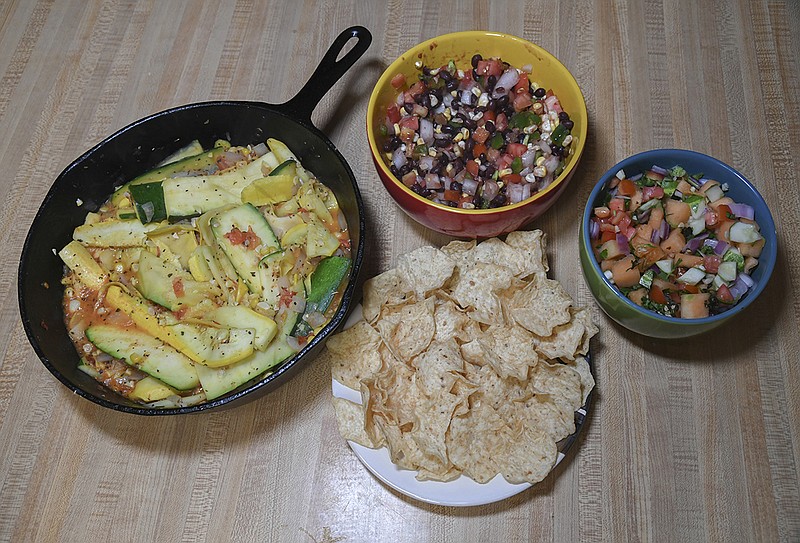Eating seasonal produce and benefiting the earth go hand in hand. Sustainability, cost-effectiveness and health benefits are all tied together when eating seasonal and local. The climate in Garland County allows us to grow almost all the most common types of fruits and vegetables. By following the growing seasons, we can eat a variety of locally grown food and save money while getting the most nutrition for our food dollars.
Choosing locally produced, seasonal foods promotes sustainability in a variety of ways. Whether it is from a local farmer or you have grown it yourself, you can know what production methods were used. If you grew it yourself, you can contact your local Extension office for best practices and times to grow produce in your area. Local produce does not have to travel long distances to reach your home helping reduce the carbon footprint created by that food.
When fruits and vegetables come into season in an area, the supply is bountiful and less is spent on transportation. Seasonal foods typically will have lower prices allowing for cost-saving. Not only will your food dollar stretch further by buying seasonal, but you also support the local economy. One study found that 68% of money spent at local businesses stays in the community. This is good news for the economy, but also for the continued sustainability of local markets. Plentiful supplies also make it a good time to preserve your own foods making it possible to enjoy the bounty all year long while saving money and knowing how your food was prepared.
Health benefits go hand in hand with seasonal foods. Eating with the seasons encourages the consumption of a greater variety of foods. Instead of just eating the same canned fruits and vegetables available at the supermarket, consuming an assortment of seasonal foods provides a greater variety of vitamins, minerals, antioxidants, and other important nutrients. The fresher the food, the more nutrition, and flavor it has when harvested at the peak of ripeness. Produce that is picked days or weeks prior to consumption or is force-ripened tends to be less flavorful than fresh, vine-ripened fruits or vegetables.
Taking a trip to the local farmers market or growing your own food in a garden or pots allows you and your family an opportunity to reconnect to the earth. Families can enjoy walking around the market while talking about all the delicious ways to prepare fruits and vegetables. Children learn life skills and appreciation of the physical and economic cost of food by maintaining a home garden. Educating our children about the value of purchasing locally and seasonally can prepare them to make food choices that will sustain the health of their community and themselves.
If you would like more information on how to grow your own seasonal fruits and vegetables as well as easy and nutritious ways to prepare or preserve them, contact the Garland County Extension office at 501-623-6841 or email [email protected]. Follow us on Facebook by liking our pages: @GarlandFCS, @garlandEGF and @GarlandCountyEHC.
Cantaloupe Salsa
Makes 6 servings
Ingredients:
¼ cup of lime juice
½ tsp. of salt
½ cup of fresh chopped cilantro
1 small cucumber, seeded and diced
1 medium red onion, finely diced
1 jalapeño pepper, minced
2 cup diced cantaloupe
2 cloves of garlic, minced
4 Roma tomatoes, chopped
Instructions:
1. In a bowl, mix all ingredients together. Cover, and refrigerate for at least 30 minutes before serving.
2. Serve with baked tortilla chips.
Nutritional Information: 35 kcal; Fat, 0; Sodium, 210 mg.; Carbohydrates, 9g.; Fiber, less than 1g.; Protein, less than 1 g.; Sugars total 8 g.; a great source of vitamin C.
Recipe adapted by Alison Crane from EFNEP
Farmers Market Salsa
Makes 8 servings
Ingredients:
½ cup of corn, cooked fresh, frozen or canned
½ cup of onion, diced
½ cup green pepper, diced
½ cup Picante sauce
1 can (15 oz.) of drained and rinsed black beans
1 cup of fresh tomatoes, diced
2 Tbsp. of lime juice
2 cloves of garlic, finely chopped
Instructions:
1. Combine all ingredients in a large bowl. Chill until serving time.
2. Drain before serving.
3. Serve with low-fat baked tortilla chips or fresh vegetables.
Nutrition Information: 70 kcal; Carbs, 13g.; Fiber, 4g; Protein, 4g; Sodium, 290mg; 20% DV vitamin C; Fat, 0; Cholesterol, 0.
Recipe adapted by Alison Crane from Arkansas SnapEd
Farmers Market Vegetable Medley
Makes approximately? 1/2 cup servings
Ingredients:
¼ tsp. of pepper, freshly ground
½ tsp. of basil, dried or 1½ tsp. of fresh basil
½ cup of corn, fresh or frozen
1 Tbsp. of margarine or butter
1 clove of garlic, minced
1 medium onion, diced
1 medium zucchini, sliced thin
2 medium yellow summer squash, sliced thin
3 medium fresh tomatoes, diced
Instructions:
1. In a large skillet over medium heat, melt margarine or butter.
2. Add onion and sauté 3 to 4 minutes or until almost transparent.
3. Add squash and zucchini. Sauté until fork tender.
4. Add tomatoes, corn, garlic, and seasonings and cook another 2 to 3 minutes.
5. Serve immediately as a side dish or as a cooked salsa to top a variety of dishes including tacos or burritos, etc.
Nutritional Information per ½ cup serving: 63 kcal; Fat, 2.6g; Sodium, 38mg; Carbohydrates, 10.1g.; Calcium, 29mg; Iron, 1mg; Potassium 470mg.
Recipe adapted by Alison Crane from http://www,uaex.edu
